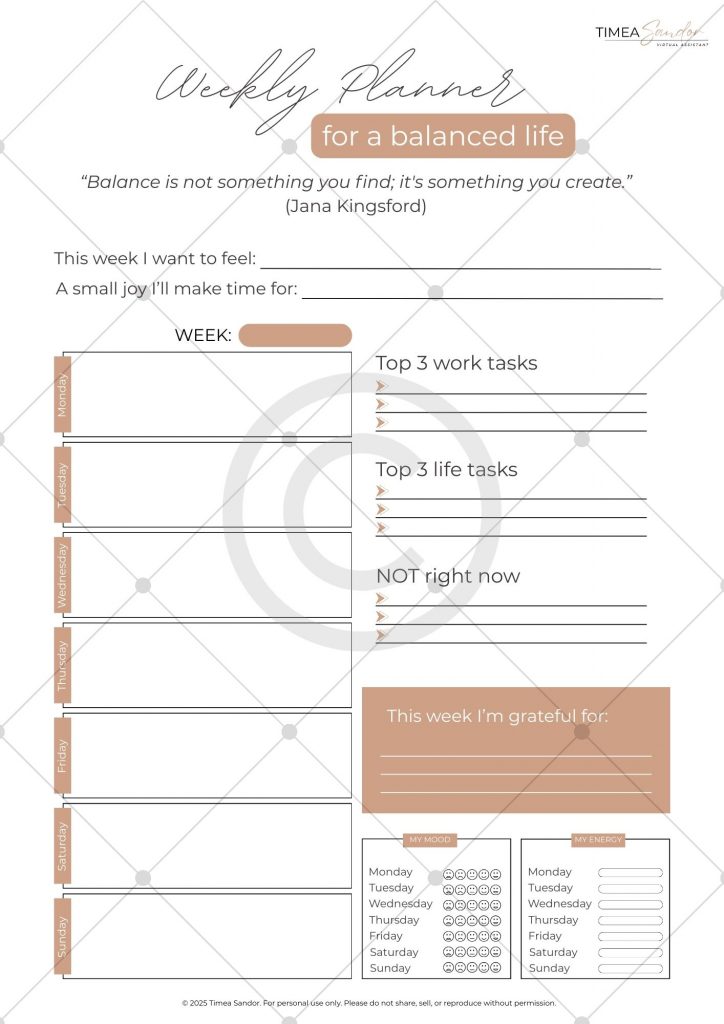Because balance isn’t something you find – it’s something you create.
If you read my last blog post, you know I hit a bit of a wall recently. Burnout, exhaustion, and the sense that I was doing everything and yet not feeling great about any of it. This post is the follow-up – not just another pep talk, but a little something that might help. A tiny step forward. A way to start rebuilding, gently and intentionally. Because balance isn’t a magical destination you arrive at one day. It’s something you build – slowly, imperfectly – and I’m starting to realise that more and more as I continue this journey.
And while I was in the middle of figuring all this out, I created something that really helped me – and I thought it might help you too. It’s called the Weekly Planner for a Balanced Life, and it’s my little love letter to anyone trying to do all the things without losing themselves in the process. It’s simple, flexible, and designed to support both your work and your wellbeing.
I’m officially sharing it today, and you can download it for free below.

Weekly Planner for a Balanced Life
The 5 Principles of Planning for Balance
This is the heart behind the Weekly Planner for a Balanced Life I created – a tool to help bring a bit more calm and intention into the chaos of everyday life. Each section is rooted in one of these principles:
1. Prioritise with Purpose: Focus on the essential
Easier said than done, right? Most of us have a million things buzzing around in our heads that all feel urgent. Choosing just a few essentials can be surprisingly difficult – but it’s absolutely worth it. It requires a big mindset shift: convincing ourselves that not everything is urgent, and not everything needs to happen right now. Certain tasks can wait. No one will die if we take it a bit easier. The world won’t end if you don’t tick off 27 items from your to-do list this week. Prioritising with purpose is an act of self-respect, not laziness.
2. Protect Your Energy: Be mindful of what you spend it on
When you’re in a state of burnout (or near it), your energy is minimal. It’s precious. Tracking your mood and energy each day takes just a few seconds, but it’s powerful. Over time, you’ll start to notice patterns, and that knowledge helps you plan your life in a way that honours your limits.
For anyone who menstruates: hormones hugely impact your energy and mood too. There’s brilliant information out there about planning your life around your menstrual cycle. It’s a whole world worth exploring if you want to fine-tune your self-awareness even further.
Bottom line: knowing when you’re likely to be low on energy helps you be kinder to yourself.
3. Not right now: Know what not to do
This is hands down my favourite principle. My mind is constantly full – ideas, tasks, random thoughts, responsibilities, new projects – it’s never-ending. If I don’t empty it out somewhere, it becomes overwhelming very quickly. The “Not Right Now” section is the designated place for all those things: brilliant, exciting, non-essential ideas that can wait. Writing them down is such a relief. It’s a way of saying: “I see you. I value you. But not this week.” And trust me, it’s essential for staying sane in a noisy, shiny, distracting world.
4. Make Space for Joy: Schedule joy like a meeting you can’t cancel
Let’s be honest – joy doesn’t always just happen in a busy life. I’m a mum to a two-year-old, and let me tell you: mum guilt is real. There’s this impossible internet-fuelled ideal where you’re supposed to spend every waking moment with your child, keep a spotless home, cook organic meals from scratch, and raise a perfectly broccoli-loving, screen-free angel… and if you fail at any of it, well, congratulations, you’ve just “ruined their life forever.” 🙃
That’s nonsense. You are allowed to have needs. You are allowed to recharge. You are allowed to be human. So, whatever lights you up – a coffee date with a friend, a walk alone, a yoga class, blasting ’90s pop music in the kitchen – schedule it. Put it in your planner and treat it as sacred. You can’t pour from an empty cup.
5. How Do You Want to Feel? Plan backwards from your desired feeling
When you’re burnt out, it’s so easy to get stuck in survival mode. Instead, ask yourself: How do I want to feel at the end of this week? Calm? Energised? Connected? Capable? Then think through what actions, boundaries, or little shifts could help move you toward that feeling. It gives your week a purpose beyond just ticking off tasks. It helps you build a life that feels good, not just one that looks busy.
How to Use the Balanced Business Weekly Planner
Now let’s walk through the planner itself, step by step. It’s a one-pager, clean, gentle, and clutter-free, and it’s meant to work with your life, not add pressure to it.
Start with the Week
At the top, just note the week you’re planning for. This isn’t a planner you have to use every single week without fail.
It’s a tool you can come back to when you need to reset. Use it consistently, or drop in when things feel messy – it’s flexible either way.
Top 3 Work + Life Tasks
This is your focus zone. Each week, pick up to three key work tasks and three key life tasks. They should be doable, not overwhelming – things that truly need to happen for you to feel like you’ve moved forward.
Pro tip: These can be small. For me, “book a dentist appointment” or“send that awkward email” often make the list. Because when they’re done, I breathe easier.
“NOT Right Now”
Have a running list of things popping into your brain at 3 am? This is where they go. Dump them here instead of onto your main list – they’re still visible, but they’re not your priority this week. This can reduce decision fatigue so much. And if you’re prone to chasing new ideas (hello, Pinterest rabbit holes), this space is essential
“A Small Joy I’ll Make Time For”
This is joy on purpose. Add one thing – just one! – that brings you delight. It doesn’t have to be impressive. A podcast episode, a walk, an early night, dancing around to Michael Jackson. Whatever makes you feel alive and like yourself again. Trust me, it matters.
“This Week I Want to Feel…”
Choose one word or phrase that captures how you’d like your week to feel. It can be anything – peaceful, focused, playful, rested. Let that intention shape how you plan and how you say yes or no to things.
Mood & Energy Check-ins
A tiny check-in space for each day of the week. Just jot down how you felt emotionally and how your energy was. Over time, this becomes a great self-awareness tool. It helps you plan better, be kinder to yourself, and notice what drains or lifts you.
“This Week I’m Grateful For…”
End the week by reflecting on something good. It doesn’t have to be deep or profound – “a hot cuppa while it was raining” totally counts. Gratitude helps you end the week grounded, even if it was a bit of a mess.
Want the Planner?
If this sounds like the kind of planning you need in your life, you can download my Balanced Business Weekly Planner for free! It’s printable, flexible, and designed to support you – not just your business.
If you’re reading this and feeling a bit wobbly too – I get it. Life can be a lot sometimes. But you don’t have to be perfect to build a life that feels good. One week, one breath, one small step at a time – you’re already doing more than you realise. 💛



